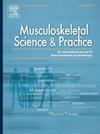Physiotherapists’ beliefs of the working mechanisms of manual therapeutic techniques for spinal pain relief: a quantitative content analysis
IF 2.2
3区 医学
Q1 REHABILITATION
引用次数: 0
Abstract
Background
Manual therapeutic techniques (MTTs), including high velocity thrust manipulation (HVT) and spinal mobilization (MOB), are used to reduce spinal pain. Physiotherapists' beliefs on their working mechanisms to relieve pain are unknown.
Objectives
To explore the prevalence of physiotherapists’ beliefs regarding the working mechanisms of MTTs on pain relief and their associated factors.
Design
Quantitative content analysis.
Method
The results of the verbal and online survey were analyzed based on a theory-driven coding framework (categories and depth). Ordinal, linear, and nominal regression analyses were used to analyze the secondary aim.
Results
A total of 541 physiotherapists were included (survey, n = 383, 70.8 %; verbal surveys, n = 158, 29.2 %), resulting in 759 HVT and 713 MOB responses. Six categories were present: biomechanical (39.3 % HVT, 50.9 % MOB), neurophysiological (39.4 % HVT, 31.4 % MOB), immunological (2.0 % HVT, 1.1 % MOB), non-specific (13.4 % HVT, 14.2 % MOB), unknown (4.3 % HVT, 1.3 % MOB), and not categorizable (1.6 % HVT, 1.1 % MOB). Levels of depth were low (65.1 % HVT, 64.1 % MOB), moderate (17.3 % HVT, 19.0 % MOB), and high (17.4 % HVT, 16.8 % MOB). Having a Master degree, network participation and work experience were associated with the category of working mechanism, level of depth and number of working mechanisms.
Conclusion
The beliefs of physiotherapists in the Netherlands regarding the working mechanisms of MTTs for spinal-related pain reduction are mainly biomechanical and neurophysiological. The working mechanisms were dominantly explained in an unifactorial manner and with a low level of depth. Having a Master of Science degree was strongly associated with more evidence-consistent beliefs and deeper understanding.
物理治疗师对脊柱疼痛缓解的手工治疗技术的工作机制的信念:定量内容分析
手工治疗技术(mtt),包括高速推力操作(HVT)和脊柱活动(MOB),用于减轻脊柱疼痛。物理治疗师对他们减轻疼痛的工作机制的信念是未知的。目的探讨物理治疗师对mtt缓解疼痛的作用机制及其相关因素的看法。定量内容分析。方法基于理论驱动的编码框架(分类和深度)对口头调查和在线调查结果进行分析。使用顺序、线性和名义回归分析来分析次要目标。结果共纳入541名物理治疗师(n = 383,占70.8%;口头调查,n = 158, 29.2%),结果有759例HVT和713例MOB反应。存在6种类型:生物力学(39.3% HVT, 50.9% MOB)、神经生理学(39.4% HVT, 31.4% MOB)、免疫学(2.0% HVT, 1.1% MOB)、非特异性(13.4% HVT, 14.2% MOB)、未知(4.3% HVT, 1.3% MOB)和不可分类(1.6% HVT, 1.1% MOB)。深度分为低(65.1% HVT, 64.1% MOB)、中(17.3% HVT, 19.0% MOB)和高(17.4% HVT, 16.8% MOB)。硕士学历、网络参与程度、工作经验与工作机制类别、工作机制深度和工作机制数量相关。结论荷兰物理治疗师对mtt治疗脊柱相关疼痛的作用机制的看法主要是生物力学和神经生理学。对其作用机制的解释以单因素为主,深度较低。拥有理学硕士学位与更有证据的信念和更深刻的理解密切相关。
本文章由计算机程序翻译,如有差异,请以英文原文为准。
求助全文
约1分钟内获得全文
求助全文
来源期刊

Musculoskeletal Science and Practice
Health Professions-Physical Therapy, Sports Therapy and Rehabilitation
CiteScore
4.10
自引率
8.70%
发文量
152
审稿时长
48 days
期刊介绍:
Musculoskeletal Science & Practice, international journal of musculoskeletal physiotherapy, is a peer-reviewed international journal (previously Manual Therapy), publishing high quality original research, review and Masterclass articles that contribute to improving the clinical understanding of appropriate care processes for musculoskeletal disorders. The journal publishes articles that influence or add to the body of evidence on diagnostic and therapeutic processes, patient centered care, guidelines for musculoskeletal therapeutics and theoretical models that support developments in assessment, diagnosis, clinical reasoning and interventions.
 求助内容:
求助内容: 应助结果提醒方式:
应助结果提醒方式:


